
http://www.iaeme.com/IJM/index.asp 81 editor@iaeme.com
International Journal of Management (IJM)
Volume 8, Issue 5, Sep–Oct 2017, pp. 81–92, Article ID: IJM_08_05_009
Available online at
http://www.iaeme.com/ijm/issues.asp?JType=IJM&VType=8&IType=5
Journal Impact Factor (2016): 8.1920 (Calculated by GISI) www.jifactor.com
ISSN Print: 0976-6502 and ISSN Online: 0976-6510
© IAEME Publication
FRESHWATER FISH CULTIVATION
ECONOMY VALUE CHAIN MODEL - SURVEY
ON TWO VILLAGES IN SUBANG AND
PURWAKARTA
Aminuddin Irfani and Muhardi
Faculty of Economics and Business, Universitas Islam Bandung
ABSTRACT
Different with the people in Nagrog Village, most of the people in Mayang village
are freshwater fish cultivators. However, there are several problems connected with
cultivation, especially on the cultivation institutional and management, such as not
optimized group functions and individualized cultivation production marketing. The
problems in both aspects bring serious effects on freshwater fish cultivation’s value
chain. The existence of the problems, drive interest to further acknowledge about: (1)
the primary and supporting aspects of freshwater fish cultivation in both villages; and
(2) freshwater fish cultivation’s economy value chain in both villages. The method
utilized in this research is a descriptive survey with data collection through depth
interview through focus group discussion with local government, stakeholders, and
freshwater fish cultivation cultivators. The result of this research are: (1) the
freshwater fish cultivation in both village includes input market, operational activity,
distribution, human resource development, and cultivation technology; (2) there are
weaknesses in the primary and support activities of freshwater fish cultivation in
Mayang Village, which produced by a weak non-physical infrastructure, cultivation
technology utilization, and cultivator human resource development. Meanwhile, in
Nagrog Village these weaknesses are not found due to strategic roles played by
cultivator business group.
Key words: Fish cultivation economy, value chain model, freshwater fish cultivation.
Cite this Article: Aminuddin Irfani and Muhardi, Freshwater Fish Cultivation
Economy Value Chain Model - Survey on Two Villages in Subang and Purwakarta.
International Journal of Management, 8 (5), 2017, pp. 81–92.
http://www.iaeme.com/IJM/issues.asp?JType=IJM&VType=8&IType=5
1. INTRODUCTION
Freshwater fish cultivation has become a significant economic activity for the society both in
Mayang and Nagrog Village, and the high level of water and human resource availability, are
the main factors that push freshwater fish cultivation activity. Based on initial research,
despite the difference of economical contribution level, the business plays a significant role in

Aminuddin Irfani and Muhardi
http://www.iaeme.com/IJM/index.asp 82 editor@iaeme.com
these villages economy dynamization. However, cultivators in Nagrog Village provide a
lower contribution despite their high level of productivity compared with the ones in Mayang
Village. This situation happens because the majority of the people in Mayang Village are
freshwater cultivators. Meanwhile, the people of Nagrog Village is more interested in rice
farming.
Regardless of freshwater cultivation sector’s domination in Mayang Village, the people
are still practicing their business individually. This management method includes their
activities in input market such as fish seeds and feeds procurement, and output market as a
mean to sell their products. The existence of this individualism is weakening their bargaining
power against both input or output market.
The inexistence of business group brings out an opportunity for several cultivators to take
a second role as middlemen, to gain extra profit in the form of distribution service for other
cultivators, especially in input and output market activities. Nevertheless, these internal
middlemen only play a minimum role because they will only distribute the fish commodity to
other intermediaries with a larger scale from outside of the village. This extra chain in the
freshwater fish cultivation business value chain of Mayang Village’s cultivator has produced
an urgency for business group formation. On the other hand, the cultivators in Nagrog Village
have already benefitted the existence of business group collectively. The business group also
plays a major role in every aspect of their business, starting from activities in input market to
various activities in the output market. Despite the maximization of the business group, there
is still weakness in the capital system and production optimization, which is caused by lack
Initiative to access capital source.
Identification of the cultivation situation in both of these villages based on initial research,
produce a high motivation to conduct a research to acknowledge further; (1) the primary and
support activities of freshwater fish cultivation in both village; and (2) these villages’
freshwater fish cultivation economy value chain.
2. LITERATURE STUDY
Value chain optimization is an important aspect to improve agricultural businesses, including
freshwater fish cultivation, to reach sustainability. With an optimized value chain, business
activities will have a stronger structure, and profit optimization achievement would be a lot
easier. Every aspect in supply chain plays a significant role in value creation process, and
their condition will significantly influence other areas of the value chain. This situation is in
parallel with Stratan et. al. (2012), which states that in a supply chain, various important
activities will help value creation such as production, raw material processing, and disposal
after utilization. Barber’s (2008) statement, further amplify this statement by claiming that
value creation in the supply chain can occur either in tangible or intangible chains.
In a value chain, there are two groups of activities. The first group consists of primary
activities, which are inbound logistics, operations, outbound logistics, marketing and sales,
and service. Meanwhile, the second group includes support activities, which are procurement,
technology development, human resource management, and a solid infrastructure (Porter,
1998).
It is important to enhance communication effectivity, knowledge sharing, and trust in
every aspect of the value chain to create a sustainable and stable value chain(Lewis et. al.,
2014). The value chain in fish cultivation business has a major role to build society tenacity
and has a high and broader influence towards national economy. Following that, Higgins et.
al. (2010) state that value chain has a fundamental role in the society and national economy

Freshwater Fish Cultivation Economy Value Chain Model - Survey on Two Villages in
Subang and Purwakarta
http://www.iaeme.com/IJM/index.asp 83 editor@iaeme.com
sustainability, and to improve producer’s stability and prosperity whether individually or
collectively.
The basic thing to create sustainability is to improve the balance of cooperation program
and supportive government (Yusuf and Trondsen, 2013). The government should be able to
cooperate with the cultivators to create regulations that can improve the people’s prosperity
and economic system (Kabu and Tira, 2015). To improve basic understanding and business
sustainability, the government should prioritize communication with the cultivators (Donovan
et. al., 2015). Government contribution can benefit every personnel involved in fish
cultivation sector, such as the involvement of the cultivators to form various value chain
strengthening concept so that the implementation of this concept would be sustainable and can
bring a maximum profit for the freshwater fish cultivation cultivators.
Improvement of capital provision and processing technique will provide ways for
cultivators to involve themselves in the value chain and improve business sustainability
(Choudary et. al., 2015). Meanwhile, according to Ros-tonen et. al. (2015), to improve market
productivity and integration, value chain collaboration is essential. Therefore, it is important
for the cultivators to develop a strategic partnership to fulfill customer’s demands (Stevenson
et. al., 2011). The strategic collaboration will further be able to facilitate product quality
creation, product differentiation, and a balanced distribution for the cultivators (Lev and
Stevenson, 2011). However, Ricketts et. al. (2014) mentioned that participation in value chain
wouldn’t be able to bring a significant contribution to value chain improvement.
The government collaboration and participation on fish cultivation business would bring a
significant impact. One of the impacts is the emergence of various changes in the value chain,
whether from structural or cost perspective. The existed transformation should provide a
chance to exploit value chain to maximize profit through market access refinement (Fatima et.
al., 2016). Changes in business processing system will influence the customer, especially on
their consumption activity. The change will increase market attractiveness for the cultivators
in an attempt to fulfill the existing demand. As mentioned by Zylberberg (2013), customer
behavior transition increases business attractiveness and further inspire the creation of a long-
term improvement strategy.
Product differentiation is one of the most important things to improve business
sustainability. However, product differentiation realization should be equipped with relevant
information, so that the cultivators would be able to create a better linkage with the customers
(Buskirk et. al., 2013).
3. RESEARCH METHOD
The Method utilized in this research was descriptive survey method. Descriptive technique
expected to be able to reveal problems that occur in this business. Meanwhile, the survey
technique was utilized to acknowledge the value chain of freshwater fish cultivation and
explains various phenomenon faced by the cultivators in Mayang and Nagrog Village, in the
management of their businesses.
Primary data collection, which is essential for this research was obtained through
interview, observation, and information analysis. This information was directly collected
through field survey in the form of depth interview (Focus Group Discussion / FGD) with
local government, connected stakeholders, and the cultivators of both villages. Meanwhile,
secondary data was collected from relevant agencies, such as district and village offices. The
collected data further analyzed with value chain analysis technique to acknowledge the

Aminuddin Irfani and Muhardi
http://www.iaeme.com/IJM/index.asp 84 editor@iaeme.com
primary and support activities in freshwater fish cultivation, and to provide a profound
understanding of freshwater fish cultivation businesses in both villages.
4. RESULT AND DISCUSSION
4.1. The Primary and Support Activities of Freshwater Fish Cultivation
Freshwater fish cultivation and rice farming businesses have been dominating Mayang
Village's economic sector. Although those two sectors play a balanced role in the people’s
economy, fish cultivation industry provides larger income for the society compared with
farming sector. Despite the business scale that is relatively small, the quality of freshwater
fish cultivation product in Mayang Village is pretty decent. This level of product quality,
further impacting the customer consumption behavior and creates a recurring purchase,
although the purchase quantity is rather fluctuating and unstable.
Despite the high business interest, there are still potential areas yet to be utilized by the
society. The inability to optimize field utilization is caused by the people’s weakness in
capital provision ability, and only able to benefit a self-provided capital without any access on
a larger capital system. Because of that, it can be stated that the business scale, which is
minimum, is generated due to a limited amount of working capital. The cultivators also
generally sell products in the form of fresh fish, without any further processing activity. This
marketing behavior creates a limited added value on their products and a one-door income for
the cultivator society.
The people of Mayang Village are still conducting their businesses traditionally, without
technological utilization due to minimum knowledge in the field of cultivation technology. In
reality, the cultivators receive annual training to improve their knowledge about cultivation
technology. However, in practice, the training is limited to only three people, and there is no
official forum or group where they can distribute the knowledge gained from the training.
Figure 1 The Primary and support activities of Freshwater Fish cultivation in Mayang Village
Marketing and
Selling:
Internal and external
middlemen has a
dominant role in
marketing and selling
(there is an
asymmetrical
information)
SUPPORT ACTIVITIES
PRIMARY ACTIVITIES
Infrastructure: (1) available field (there are several idle field), (2) large quantity of water source,
irrigation, inadequate roadways, (3) absence of fish processing factory to create added value, (4) no
business group especially cooperation, (5) weak capital access, (6) self-provided capital.
Human resource: (1) there is an annual trainingprogram, however the impact of the training program is
yet to reach optimum level, (2) cultivation business conducted individually (low bargaining power against
input and output market), and (3) fresh water fish cultivation skill regenerated across generations.
Technology development: (1) static cultivation method (traditional); and (2) there is no significant
improvement in cultivation technology.
Procurement: (1) the existence of asymmetrical information against input market; (2) product marketing in
form of raw products; (3) product provision that is based on inner driving force causes fluctuative selling
price; (4)seeds and feeds quality is difficult to control; and (5) economic of large scale is not presented.
Inbound Logistic:
Weak input market
bargaining power
(individualy
conducted business).
External middlemen
has dominant
bargaining power on
both input market.
Operation:
Static fishery
cultivation
management.
Cultivation
without standard
operation
procedure.
Outbound
Logistic:
Weak output
market bargaining
power; internal
middlemen play
a dominant role in
output logistic
distribution.
Service:
Post marketing
service in form of
information
provision and
continued product
distribution
practiced by the
middlemen
Fishery
as The
Village’s
Main
Leading
Sector

Freshwater Fish Cultivation Economy Value Chain Model - Survey on Two Villages in
Subang and Purwakarta
http://www.iaeme.com/IJM/index.asp 85 editor@iaeme.com
The practice of cultivation science and technology by the society is passed through
generations because the cultivators are more confident in practicing these techniques. The
cultivator’s weak initiative to apply knowledge gained by some of the cultivators from
annually conducted training programs, creates limitations for the cultivators, especially from
the quality perspective.
The cultivator’s business activity is driven by inner driving force or motivation that
emerges due to personal needs. This type of motivation is further drives the cultivators to
limit their production level based on their needs. This situation results from low attention
from the cultivators towards their production quantity and brings influence on commodity
price stability. Furthermore, marketing activity that is conducted individually also contributes
to price stability degradation.
Figure 2 The Primary and support activities of Freshwater Fish cultivation in Nagrog Village
Business individualism practiced by cultivators in Mayang Village makes it more difficult
for the society to form a business group that would be able to accommodate every activity
either in input or output market. Raw materials such as seeds and feeds procured from input
market performers, which is located outside of the village. This situation forces the cultivators
to purchase their raw materials with a relatively higher material price because of extra cost
generated from distribution activity. Some cultivators that have more capital than the others
view this obstacle as an opportunity to gain extra profit by taking a role as distributor, or
which is known as middlemen by the locals. The existence of these intermediaries agent
apparently failed to bring positive impacts for the cultivators. If fact, they have become one of
the problems, and widen the asymmetrical information gap between the cultivators and input-
output market. The internal middlemen (that comes from inside of the village), only
functioned as a temporary distributor for external middlemen, without any ability to influence
Marketing and
selling:
Cultivation group
that plays a
dominant role in
marketing and
selling creates an
organized
marketing (well-
known target
market).
SUPPORT ACTIVITY
PRIMARY ACTIVITY
Infrastructure: (1) limited cultivation space; (2) large quantity of water source, irrigation,
adequate roadways; (3) the existence of business group; (4) government provides training
programs, and (5) external capital provision availability.
Human resource: (1) trainings for cultivators as members of business group; (2) collective
business through official business group’s involvement; (3) the cultivators are generally on a
productive line of age.
Technological development: (1) cultivation process utilizes technological knowledge; (2)
marketing process have started to involves technological utilization such as social media.
Procurement: (1) relatively stabilized output market price; (2) product selling in form of raw
material; (3) standardized cultivation period influences product availability; (4) input quality is
well-controlled; and (5) the existence of economic of large scaleconcept in input output market
activity through business group.
Inbound
logistic:
Strong
bargaining
power against
input market.
Strong role from
business group
in procuring
input
commodity
Operation:
The involvement
of a decent fish
cultivation
program, dynamic
cultivation method
improvement
andstandard
operation
procedure.
Outbound
logistic:
Strong bargaining
power against
output market.
Strong role from
business group in
coordinating
input commodity
dan terjadwal.
Service:
A clear post
marketing
service in
form of
information
provision and
continued
product
distribution
Fishery
as The
Village’s
Main
Leading
Sector





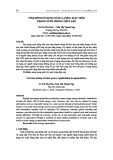

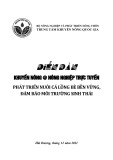
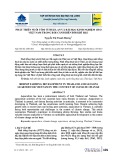
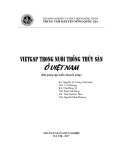


![Kỹ thuật nuôi thâm canh cá lóc trong ao đất: Tài liệu [chuẩn/mới nhất]](https://cdn.tailieu.vn/images/document/thumbnail/2025/20250724/kimphuong1001/135x160/3731753342195.jpg)




![Kỹ thuật nuôi cá nâu trong ao đất: Tài liệu [Mới nhất]](https://cdn.tailieu.vn/images/document/thumbnail/2025/20250723/vijiraiya/135x160/29781753257641.jpg)
![Kỹ thuật nuôi cá mú trong ao đất: Tài liệu [Mới nhất]](https://cdn.tailieu.vn/images/document/thumbnail/2025/20250723/vijiraiya/135x160/85681753257642.jpg)



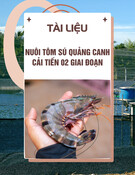
![Kỹ thuật nuôi tôm sú quảng canh cải tiến 2 giai đoạn: Tài liệu [Chuẩn nhất]](https://cdn.tailieu.vn/images/document/thumbnail/2025/20250722/vijiraiya/135x160/77611753171890.jpg)

![Quy trình kỹ thuật nuôi tôm siêu thâm canh công nghệ biofloc: Tài liệu [chuẩn/mới nhất]](https://cdn.tailieu.vn/images/document/thumbnail/2025/20250722/vijiraiya/135x160/99851753171891.jpg)
